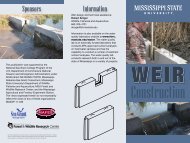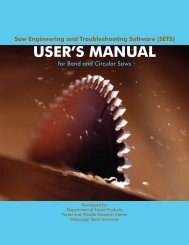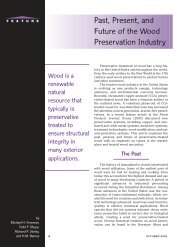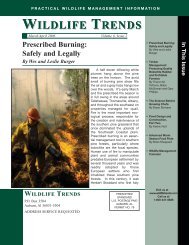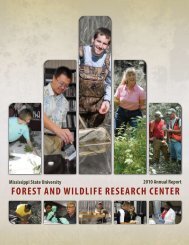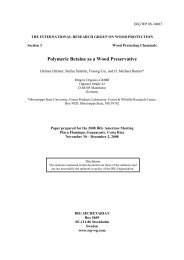Restoring Bobwhite Quail Habitat - Forest and Wildlife Research ...
Restoring Bobwhite Quail Habitat - Forest and Wildlife Research ...
Restoring Bobwhite Quail Habitat - Forest and Wildlife Research ...
Create successful ePaper yourself
Turn your PDF publications into a flip-book with our unique Google optimized e-Paper software.
Incentive<br />
payments<br />
4Signing Incentive Payments of up to $100 per<br />
acre.<br />
4Annual rental payments <strong>and</strong> maintenance costs.<br />
Producers will receive annual rental payments<br />
for the length of the contract (10 years). The<br />
payment is a weighted average of the county<br />
specific rental rate for comparable l<strong>and</strong>, plus<br />
practice maintenance ($5 acre per year).<br />
4Cost-share assistance of up to 50% of the eligible<br />
reimbursable practice costs.<br />
4Practice Incentive Payments of up to 40% of the<br />
eligible establishment cost.<br />
Sign-up<br />
Program sign-up at local Farm Service Agency offices<br />
begins October 1, 2004, <strong>and</strong> will run on a continuous<br />
basis (meaning eligible l<strong>and</strong> may be enrolled at any<br />
time) until the state’s 9,400 acres have been enrolled,<br />
or December 31, 2007, whichever comes first. Eligible<br />
acres are automatically accepted instead of being<br />
competitively ranked as in the general Conservation<br />
Reserve Program.<br />
Information<br />
Additional information on the Conservation Reserve Program<br />
Northern <strong>Bobwhite</strong> <strong>Quail</strong> <strong>Habitat</strong> Initiative is available at your<br />
local USDA Farm Services Agency office <strong>and</strong> on the FSA web<br />
site at www.fsa.usda.gov<br />
Assistance<br />
Mississippi Department of <strong>Wildlife</strong>, Fisheries<br />
<strong>and</strong> Parks:<br />
Dave Godwin, 662.325.5119<br />
Mississippi Fish <strong>and</strong> <strong>Wildlife</strong> Foundation:<br />
Daniel Coggin, 662.256.4486<br />
R<strong>and</strong>y Browning, 601.296.1173<br />
Delta <strong>Wildlife</strong>, Inc.:<br />
Trey Cooke 662.686.3372<br />
Gayden Pollan 662.686.3373<br />
Mississippi State University, <strong>Forest</strong> <strong>and</strong><br />
<strong>Wildlife</strong> <strong>Research</strong> Center:<br />
Wes Burger, 662.325.8782<br />
Rick Hamrick, 662.325.5470<br />
Mark Smith, 662.325.7491<br />
FWRC<br />
Photographs by Wes Burger, Stephen Dinsmore, Fred Faulk,<br />
Joe Mac Hudspeth, USDA-NRCS<br />
Mississippi State University does not discriminate on the basis of race, color, religion, age,<br />
sex, sexual orientation or group affiliation, disability or veteran status.<br />
<strong>Restoring</strong><br />
<strong>Bobwhite</strong><br />
<strong>Quail</strong><br />
<strong>Habitat</strong><br />
A conservation practice<br />
for agricultural<br />
producers
<strong>Habitat</strong><br />
Initiative<br />
Throughout their range, bobwhite populations have declined<br />
from an estimated 59-million birds in 1980 to about 20-<br />
million in 1999. Their habitats are disappearing due to<br />
urbanization, loss of native grassl<strong>and</strong>s, intensive agriculture,<br />
<strong>and</strong> a transitioning of once grassy fields into forests.<br />
1980<br />
= 5 birds<br />
1985 1990 1995 2000<br />
average call counts over four year time periods<br />
Reverse the Trend by<br />
Creating New <strong>Habitat</strong><br />
250,000 acres<br />
35 states<br />
In late 2004, the United States Department of Agriculture’s<br />
Farm Service Agency introduced a new conservation practice<br />
under the continuous Conservation Reserve Program<br />
intended to create 250,000 acres of habitat for the northern<br />
bobwhite quail in 35 states. The Northern <strong>Bobwhite</strong> <strong>Quail</strong><br />
<strong>Habitat</strong> Initiative introduces a conservation practice of early<br />
successional native grass buffers along agricultural field<br />
margins.<br />
Conservation<br />
Practice<br />
This new conservation practice, CP 33: <strong>Habitat</strong> Buffers for<br />
Upl<strong>and</strong> Birds, provides food <strong>and</strong> cover for bobwhite quail in<br />
cropl<strong>and</strong> areas. The practice must be applied around field<br />
edges of eligible cropl<strong>and</strong>. The practice involves natural<br />
regeneration of native grasses <strong>and</strong> forbs or planting of native<br />
warm-season grasses, legumes, wildflowers, forbs, <strong>and</strong> limited<br />
shrub <strong>and</strong> tree plantings. Plantings will be specified in the<br />
program participant’s approved USDA conservation plan.<br />
Buffers have long been regarded for reducing soil erosion <strong>and</strong><br />
protecting water quality by trapping sediments, nutrients,<br />
<strong>and</strong> agrichemicals. However, research has demonstrated<br />
that grass buffers provide needed habitat for bobwhite quail<br />
<strong>and</strong> upl<strong>and</strong> birds; as well as reptiles, amphibians <strong>and</strong> aquatic<br />
species. Many of which are regionally declining <strong>and</strong> of<br />
conservation concern.<br />
Buffers not only provide food <strong>and</strong> cover for bobwhite quail<br />
<strong>and</strong> upl<strong>and</strong> birds but also reduce soil erosion from wind<br />
<strong>and</strong> water, increase soil <strong>and</strong> water quality, <strong>and</strong> protect <strong>and</strong><br />
enhance the on-farm ecosystem.<br />
Eligibility<br />
The initiative is limited to 250,000 acres in 35 states with<br />
geographic areas that have the greatest potential to restore<br />
bobwhite quail. Of these 250,000 acres, Mississippi has<br />
been allocated 9,400 acres. To be eligible, cropl<strong>and</strong> must<br />
be suitably located <strong>and</strong> adaptable to the establishment of<br />
bobwhite quail. In addition, the applicant must satisfy<br />
the basic eligibility <strong>and</strong> cropping history criteria for the<br />
Conservation Reserve Program. Cropl<strong>and</strong> does not need<br />
to be classified as highly erodible, but must have been<br />
cropped at least four out of six years (1996-2001). To<br />
determine individual eligibility for this practice, l<strong>and</strong>owners<br />
should check with their local Farm Service Agency office.<br />
<strong>Wildlife</strong> biologists listed on the back of this publication can<br />
assist with development of a conservation plan that meets<br />
l<strong>and</strong>owner wildlife objectives.<br />
CP 33: <strong>Habitat</strong> Buffers for Upl<strong>and</strong> Birds<br />
• Provides habitat for bobwhite quail <strong>and</strong> other<br />
wildlife<br />
• Provides incentive payments for producers.<br />
• Sign up begins October 1, 2004, <strong>and</strong> will run on<br />
a continuous basis.<br />
• Automatic enrollment of eligible acres.



